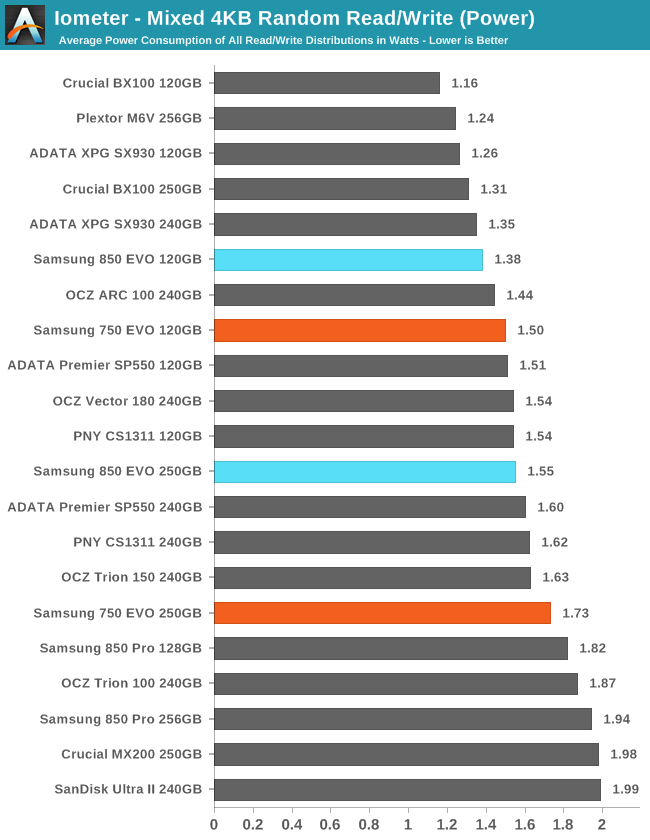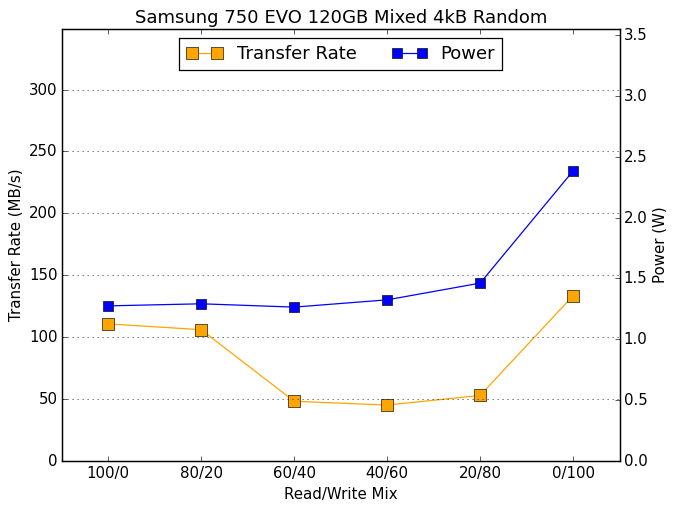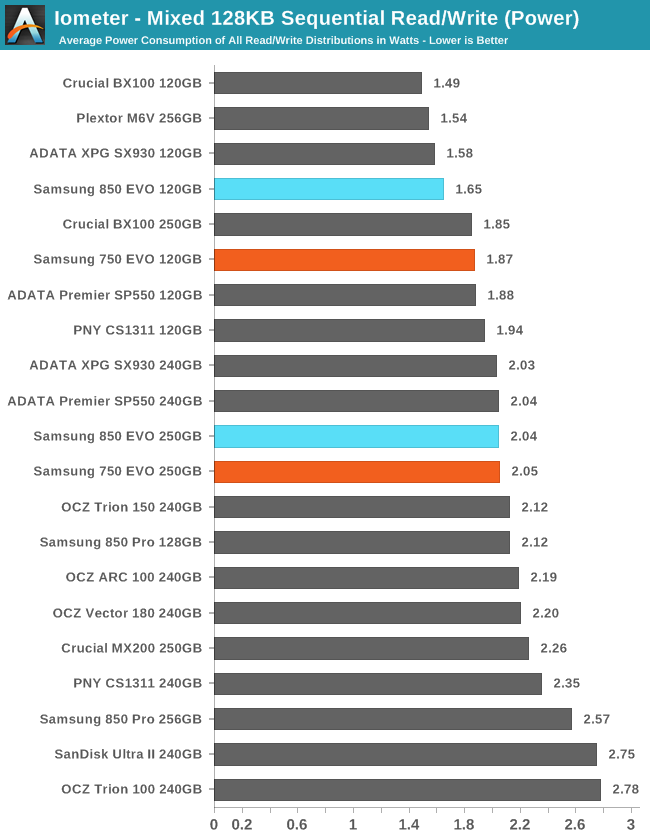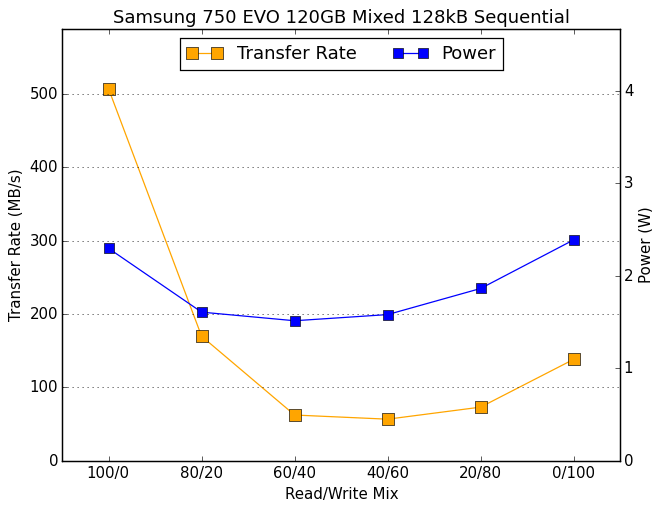The Samsung 750 EVO (120GB & 250GB) SSD Review: A Return To Planar NAND
by Billy Tallis on April 22, 2016 8:00 AM ESTMixed Random Read/Write Performance
The mixed random I/O benchmark starts with a pure read test and gradually increases the proportion of writes, finishing with pure writes. The queue depth is 3 for the entire test and each subtest lasts for 3 minutes, for a total test duration of 18 minutes. As with the pure random write test, this test is restricted to a 16GB span of the drive, which is empty save for the 16GB test file.

The 750 EVO outperforms any non-Samsung drive of similar capacity on the mixed random I/O test, and the 120GB 750 EVO even beats a few MLC drives with twice the capacity.

The 750 EVO has above-average power efficiency during the mixed random I/O test.
 |
|||||||||
Most drives lose performance during the middle phases of the mixed random I/O test. High performance scores on this test rely on performance bouncing back during the final phase of the test when the workload shifts to pure writes. The 750 EVO's spike at the end is noticeable though not huge, but it also benefits from comparatively good performance in the first two sub-tests.
Mixed Sequential Read/Write Performance
The mixed sequential access test covers the entire span of the drive and uses a queue depth of one. It starts with a pure read test and gradually increases the proportion of writes, finishing with pure writes. Each subtest lasts for 3 minutes, for a total test duration of 18 minutes. The drive is filled before the test starts.

Unlike for the mixed random I/O test, most MLC drives are able to maintain a clear performance lead over the planar TLC drives—including the 750 EVO.

The 750 EVO's power consumption is low enough that it is clearly the most efficient planar TLC drive, but its efficiency doesn't beat a typical MLC drive.
 |
|||||||||
The 750 EVO has great read speed, but it bottoms out at a relatively low level during the middle of the test and doesn't bounce back at the end as much as most MLC drives and the 850 EVO.










109 Comments
View All Comments
Bleakwise - Sunday, April 24, 2016 - link
I apologize for being rude but that's just not what they are made for. Paying 1,000$ for a 2tb NVME SSD just for cold storage is a lot like buying a 500,000$ super-car just to drop your kids off at school....Bleakwise - Sunday, April 24, 2016 - link
More like even up to 8k.A mechanical hard drive will roll out 150-200 GigaBYTES per second sequential read. 4k video is like 5 megaBYTES per second max. 8k would be 20, 16k would be 80. This is on h264, h265 will cut these in half, so you could watch a 32k video on something like a WD black.
I suppose if you wanted to play back something in 64k resolution you'd need an SSD though, at least until CPU/GPU tech makes h266 or h267 codec or whatever available.
Bleakwise - Sunday, April 24, 2016 - link
To be clear. The only reason content creators need NVME drives for 4k is because they work in uncompressed or intermediate formats. They need NVME drives for the same reason that a 4k bitmap is like 22 megabytes while the JPEG is just one or two.Eden-K121D - Sunday, April 24, 2016 - link
I think You meant MegaBYTES otherwise your hypothetical disk would be faster than anything on this planet LOLslowdemon21 - Friday, April 29, 2016 - link
SeaGate barracuda 195 MegaBytes per secBrokenCrayons - Friday, April 22, 2016 - link
Between the OS and software, my Windows desktop is currently using about 110GB of a 250GB hard drive. I don't game much, but there are handful of titles loaded on that system and I haven't exactly been working very hard at keeping my drive clean.On my primary computer (the desktop is more a network appliance than a day-to-day workstation as it runs headless now thanks to a combination of Steam in home streaming and VNC), a laptop with a 60GB SSD, there's about 35GB of free storage capacity, but the OS footprint is a lot smaller since it's a Linux box.
Granted, games are getting larger and a few newer titles I'm likely to play in the next year or so will make it necessary to start looking at more storage, but 250GB seems perfectly reasonable right now.
jabber - Friday, April 22, 2016 - link
Yeah just running 80GB of the 250GB 850EVO in my workstation. Having masses of software and data hanging around on a mchine seem crazy to me. Each to their own. However, most customers I see struggle to go over 60-70GB.bji - Friday, April 22, 2016 - link
This is because you guys don't pirate tons of movies and hoard them on SSD drives like some people who then complain about the cost of the media they use to store their pirated goods. I don't either, which is why the 250 GB SSD in my macbook pro is still only half full after nearly 4 years of use.bji - Friday, April 22, 2016 - link
BTW complaining about the cost of storage for pirated goods is like the ultimate douchebaggery imagineable. Not only are you ripping off people who worked to create the content you've pirated, you want to complain about how much money you have to pay to companies to produce the storage that you need to store it.StrangerGuy - Friday, April 22, 2016 - link
That's not ultimate pirate douchebaggery, it would be complaining why pirated videos are no longer available in Xvid because everybody should cater to people with decade old DVD players.